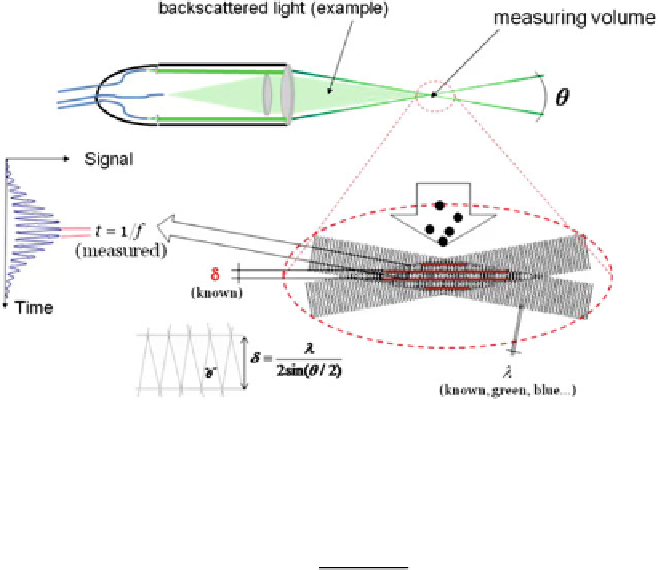Geoscience Reference
In-Depth Information
Fig. 4 Fringe model (Adapted from Dantec Dynamics LDA literature)
(Fig.
4
). The interval between peaks is
t
¼
1/
f
. Hence, the velocity of the particle
that generated the burst is:
d
t
¼
l
u
¼
f
(2)
2 sin
ð
y
=
2
Þ
The key issue for the LDA signal conditioner and signal processing units is thus
to identify bursts from background noise and to detect correctly the frequency
f
.
These units are often condensed in the Real-time Signal Analyzer (RSA) unit.
Omitting important details, the main operations undertaken in this unit are (1)
subtraction of the Gaussian pedestal inherent to a coherent laser (the radial distri-
bution of the beam intensity is approximately Gaussian), (2) amplification, (3)
filtering of noise components (general low-pass filtering), (4) burst detection, for
instance by thresholding in the time-amplitude domain, and (5) frequency estima-
tion, normally by inverse-Fourier methods. The signal-to-noise ratio and the transit
length are key parameters to verify the quality and to validate a Doppler burst.
Naturally, the larger the number of fringes, the easier to detect the burst. The
number of fringes, for an ellipsoid measuring volume, is
N
f
¼
8
F
tan(y/2)/(p
D
L
).
Hence, the larger the angle between beams and the larger focal distance, the larger
the number of fringes.
The raw LDA signal is thus composed of irregular bursts, corresponding to
particles that crossed the measuring volume, that are translated into as many
instantaneous velocities. It is current to postprocess the velocity signal into evenly
spaced velocity readings. This implies reconstruction for which there are several
algorithms using polynomial interpolation (Tropea et al.
2007
).
To distinguish between positive and negative velocities, a frequency shift in one
of the beams is introduced in the Bragg cell. The latter is composed of a glass crystal

